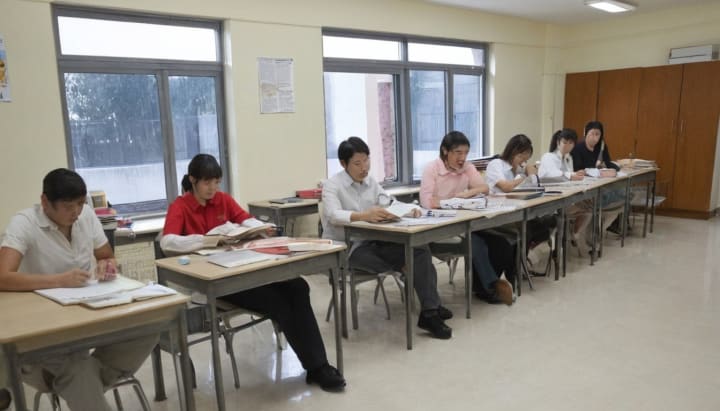Never Failing Techniques for Teachers to Discipline a Classroom
Disorder in the classroom leads to poor teaching

The First Quality of a Teacher Is the Ability to Control the Students in the Classroom
The researchers published the Study Report in the International Journal of Scientific Research. It found that 56% of students said that classroom chatter and scraping were annoying. They were from tables and chairs. These noises led to easily broken attention.
I have decades of experience working in schools. I have been both a principal and a teacher.
About class control. I have learned the first lesson: how to hold students’ attention.
Students examine their teachers according to how well they can put an end to classroom noise. When pupils are noisy, the teacher gets upset and loses interest in what they are teaching. Distracting sounds hurt the academic achievement of sincere students.
Disorder in the classroom leads to poor teaching. Even, competent teachers may have a difficult time if they have not planned.
Let Us Investigate the Problem
I was checking classes at the school as usual. I arrived at the second level. I could hear students laughing loudly from a classroom. I thought that the concerned teacher might not reach the class. In the absence of a teacher, students relaxed in their preferred style.
Whenever I checked classes, I always had the class schedule with me. I checked and found that there should not be any empty class on the second floor. The sound became clearer and louder as I moved closer to Std. 9. I positioned myself hidden behind a nearby pillar. I did this to catch the students in action while they were shouting.
Seeing Ms. Leena, the teacher, standing in the class astonished me. She was teaching some lessons. Almost half of the students were chatting. They were paying no attention to the teacher. I then came from hiding so that the students could see me. The classroom was completely silent. I watched the class for a little while before leaving.
I didn't speak with Ms. Leena. I also did not scold the undisciplined students. I did this to keep the dignity of a teacher.
Teachers Need to Analyze the Students and Themselves

Some teachers scare young pupils so they won’t talk in class. But it falls short with teenagers.
Silencing students out of fear of punishment is not effective for classroom management. Terrified children rarely learn anything. Children's curious minds go silent. If the children don’t ask questions, the point of inquiry — a vital element of education — we cannot execute.
Most teachers encounter the problem of undisciplined students to some extent. They deal with it. Sometimes teachers bear for a very long period.
Generally, teachers keep focusing on rowdy students. They don't deal with the issues that make the classroom uneasy.
In the classroom, teachers must check their behaviour. They must do so in the same way that students do with gestures and facial expressions.
If you find something in your analysis to improve, take it.
Here are some techniques. They could help teachers keep order in the classroom.
1. Establish Teacher’s Authority
Lay the foundation of a unique authority that is not forced but happily accepted. Your careful, loving supervision moves the students to follow your commands.
Create trust in students so that they feel confident and secure under your guidance. They will never fail to give you respect and appreciation. I know a lot of teachers who command such loving respect. This is what I am talking about. The teacher needs to establish.
Children make notes on every aspect of the teacher’s character. They are astute observers.
A teacher needs to act with maturity. They should use reserved words and show appropriate body language.
Students trust a teacher who knows the subject and is well-prepared.
Because of our genetic makeup, we respect those who can outwit, outsmart, and outrun us. It similarly applies to children. They desire a teacher who possesses these attributes to lead them.
Like a doctor who helps the neediest patient first, here the teacher treats the students first. The students are unknowingly disrupting the class order. Without realizing they’re spoiling themselves. They deserve a teacher’s immediate attention.
As a teacher, you never forget that you are a whole package. You have wisdom, self-control, direction, and regulation.
2. Maintain Your Commitment and Integrity
The students verify you take independent action based on what you say.
If you follow through on your words, you can impress children’s emotions.
A teacher is an unwavering supporter and motivator of their students. They are neither flexible nor inflexible. In the best interests of the pupils, they may be lenient or severe.
Make sure your kids understand the nature and character of a teacher.
Hold that, you say.
Be careful. Students often force their teachers to choose between two bad options. They then judge their reliability.
3. Never Neglect Unruly Students
Some teachers might rush to finish the curriculum. They might believe that if they ignore unruly students, the students will settle down.
Never.
Contrary to expectations, the situation would deteriorate daily. Being neutral in the matter of indiscipline is the green light.
Other students don't trust the teacher. They doubt her ability to manage the class and help struggling students. A lot of the class’s students won’t respect the teacher.
Maintaining classroom order requires you to pay close attention to the rules.
4. Identify the Unsettling Students
While teaching, teachers need to be on watch for troublemakers.
You must look at every student in the room and make eye contact. You must do this while observing their behaviour.
Talk to each restless student individually outside of the classroom, if you have any.
Inform parents about their behaviour in class, if at all workable.
Their parents will also push them to act appropriately in class.
5. Split up the Instructional Time Into Segments
Do not introduce the subject as soon as you enter the classroom.
Segment-One:
Spend some time interacting with students to get them ready to pay attention to what you have to say.
Segment-Two:
Proceed to the day’s lesson. You must allow pupils ample time to ask questions before the lesson ends.
Segment-Three:
Test how well students understand if they don’t have questions.
As a result, there are three segments for your class participation.
Instruct pupils to adhere to the segment schedule.
6. List the “Dos,” not the “Don’ts.”
Be optimistic.
There’s no need to mention your “Don’ts.”
What conduct in class do you expect from your students?
Create a chart with these points highlighted in bold and display it on the front classroom wall.
Read aloud once a week.
The method works well up to the junior level.
Driving Force

Teachers, your goal is not only to train minds but to impress hearts, too. Stay in control of yourself and maintain control over your students. Follow your work more like a passion than a profession. Be energetic, passionate, and knowledgeable.
Your presence in the class will be enough to calm down the students to listen to you attentively.
Originally published with another title on Medium
About the Creator
I. R. Pathak
Educationist by career, writer-poet by passion, thinker by nature, humorous by habit. Love to share thoughts and experience.






Comments
There are no comments for this story
Be the first to respond and start the conversation.